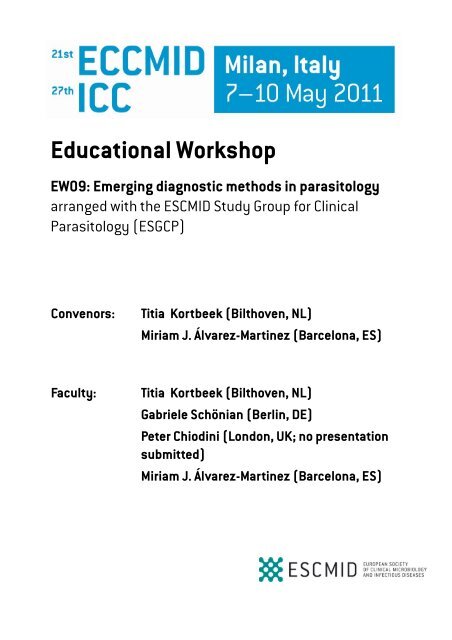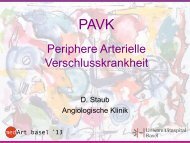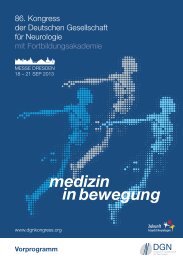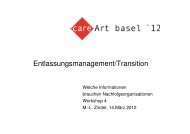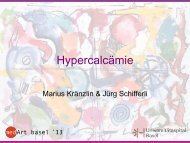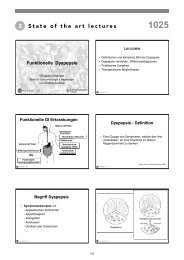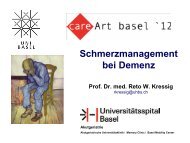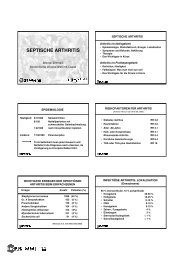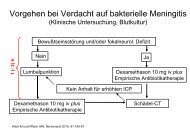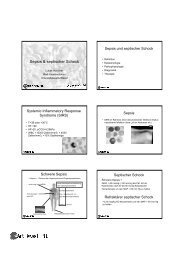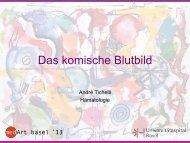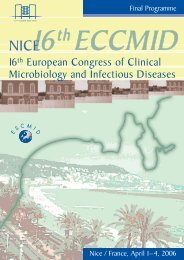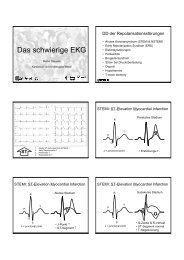Future Diagnostic Tools
Future Diagnostic Tools
Future Diagnostic Tools
You also want an ePaper? Increase the reach of your titles
YUMPU automatically turns print PDFs into web optimized ePapers that Google loves.
Educational Workshop<br />
EW09: Emerging diagnostic methods in parasitology<br />
arranged with the ESCMID Study Group for Clinical<br />
Parasitology (ESGCP)<br />
Convenors: Titia Kortbeek (Bilthoven, ( , NL) )<br />
Miriam J. Álvarez-Martinez (Barcelona, ES)<br />
Faculty: Titia Kortbeek (Bilthoven (Bilthoven, NL)<br />
Gabriele Schönian (Berlin, DE)<br />
Peter Chiodini (London, UK; no presentation<br />
submitted)<br />
Miriam J. Á Álvarez-Martinez ( (Barcelona, ES)<br />
)
Kortbeek - Intestinal parasites: microscopy, antigen detection or PCR<br />
1<br />
2<br />
Intestinal parasites:<br />
microscopy, antigen<br />
detection or PCR<br />
Titia Kortbeek<br />
Titia.kortbeek@rivm.nl<br />
Thanks to Theo Mank, Jeroen<br />
Roelfsema, Frits Franssen and LIS-<br />
PAM<br />
Educational workshop by ESCMID Studygroup<br />
for Clinical Parasitology<br />
www.escmid.org/esgcp<br />
Intestinal parasites: microscopy, antigen detection or PCR<br />
Which techniques are available<br />
● Preference microbiologist<br />
● Available equipment<br />
● Training of technicians<br />
● Volume of diagnostic requests<br />
Which parasites do you want to detect:<br />
● All<br />
● Most prevalent parasites<br />
● Only Giardia and Crypto<br />
3<br />
3
Kortbeek - Intestinal parasites: microscopy, antigen detection or PCR<br />
● Hospital setting or general practitioner<br />
● Academic -periferal hospital<br />
Patients: YOPI<br />
● Very Young, very Old, Pregnant and Immunocompromised<br />
● TTravellers ll<br />
Other available information:<br />
● Season<br />
● Duration of symptoms<br />
4<br />
<strong>Diagnostic</strong>s for intestinal parasites: What is new?<br />
● When do we need specific diagnostics?<br />
● What other information is available?<br />
● Are new methods better than the old ones?<br />
● Can we compare the results?<br />
5<br />
Intestinal parasites<br />
● Helminths or protozoa<br />
● Symptoms diarrhoea or other?<br />
– Chronic or acute<br />
● Potential life threatening or apathogenic<br />
Physical examination, clinical history, Imaging, General<br />
laboratory<br />
6<br />
4
Kortbeek - Intestinal parasites: microscopy, antigen detection or PCR<br />
● Clinical history<br />
– Medical history : underlying diseases<br />
– Immunizations/Prophylaxis<br />
– Activity/exposure or Profession<br />
7<br />
– Travel history: Destination, duration;<br />
–knowledge of occurrence of pathogens in<br />
different parts of the world:<br />
–Book announcement july 2011: Infectious<br />
Diseases A Geografical Guide Editors: Eskild<br />
– Specific food habits<br />
Petersen et al. Wiley-Blackwell<br />
Parasites in Europe : current/recent problems<br />
● Cryptosporidium in Sweden<br />
● Giardia in Norway<br />
● Trypanosoma cruzi emerging in Spain and Portugal<br />
● Echinococcus granulosus and multilocularis emerging in Baltics and<br />
other Eastern European countries<br />
● Opistorchus emering in italian lakes<br />
● Leishmania emerging to the Northern parts of Europe<br />
8<br />
.<br />
● General laboratory<br />
– Hb, leucocytes and diff (eosinophilia)<br />
– CRP, ESR, Na, K, creat,<br />
– Liver enzymes<br />
– Fever: Blood culture<br />
EEosinophilia i hili iin hhelminth l i th iinfections: f ti<br />
– can be very high but is not always present<br />
– Strongyloides, Schistosoma, Trichinella<br />
● Diarrhoea: Feces culture : Salmonella, Campylobacter, Shigella, E.coli<br />
O127;<br />
● noro virus,rota virus ( age < 8yrs),<br />
9<br />
5
Kortbeek - Intestinal parasites: microscopy, antigen detection or PCR<br />
Conventional methods for parasitological diagnostics<br />
Fresh stool sample or fresh fixated sample<br />
– Direct smear (JKJ or saline)<br />
– Concentration acc. Ridley (JKJ, saline)<br />
Depending on preference lab:<br />
– Modified Ziehl Neelsen staining or auramine<br />
(Cryptosporidium spp);<br />
– Permanent staining trofozoites protozoa:<br />
› Trichroom, Chorazol Black or FeHeKy<br />
10<br />
Conventional methods<br />
Fresh stool sample<br />
– How fresh is fresh??<br />
› Time from production of stool – arrival lab<br />
– Time from arrival lab lab- examination by technician<br />
– NB: Entamoeba are dead within an hour<br />
› Fixation with SAF<br />
Staining method:<br />
– Are all protozoa visible/ stained by this method?<br />
– Is fixation and concentration possible?<br />
11<br />
Microscopy<br />
Advantage:<br />
● Simple equipment<br />
● Cheap reagents<br />
● Relatively quick results<br />
for single sample<br />
● Most intestinal<br />
parasites can be<br />
detected<br />
12<br />
Disadvantage<br />
● Trained personel needed<br />
● Not all parasites<br />
detectable<br />
– Intermittend shedding<br />
– Trofozoites damaged<br />
(immediate fixation)<br />
– Sensitivity<br />
● Time consuming and low<br />
through-put per<br />
technician<br />
6
Kortbeek - Intestinal parasites: microscopy, antigen detection or PCR<br />
Parasites can be difficult to recognize:<br />
Mobile phone to support microscopy<br />
● Low resource setting<br />
● Suboptimal microscopy service<br />
● Misdiagnosis and improper treatment<br />
● Image capture by microscope and mobile phone camera<br />
mHealth in Low-Resourse Settings<br />
Information platform www.kit.nl/mHealth<br />
13<br />
See:http://mhealthinfo.org/map<br />
14<br />
Vol. 10 No. 3, July-September 2008<br />
Fig.1: Mobile phone microphotography: RBCs from normal<br />
blood smear<br />
(Normal blood smear under oil emersion: Zeiss Axiostar Plus Microscope,<br />
Photograph by Nokia N76 mobile camera (2 mega pixel)<br />
15<br />
7
Kortbeek - Intestinal parasites: microscopy, antigen detection or PCR<br />
16<br />
Application in parasitology in the Netherlands<br />
Trichinella in pigs: courtesy Frits Franssen RIVM-LZO<br />
● Digestion 7 wild boars<br />
● 1 living larva was detected<br />
● Contact NRL<br />
● Digestion fluid containing larva was<br />
send to NRL / RIVM Oct 14th Trichinella in pigs: courtesy Frits Franssen RIVM-LZO<br />
● Confirmation : 1 living larva<br />
– Very motile<br />
– Too big<br />
Conclusion: no Trichinella<br />
8
Kortbeek - Intestinal parasites: microscopy, antigen detection or PCR<br />
Microscopy: many intestinal parasites can be detected<br />
Protozoa<br />
● Giardia<br />
● Cryptosporidium<br />
● Entamoeba hist/dis<br />
● Dientamoeba fragilis g<br />
● Cyclospora<br />
● Cystoisospora belli<br />
19<br />
Adult worms<br />
20<br />
Helminths<br />
● Ascaris<br />
● Trichuris<br />
● Hookworm<br />
● Strongyloides<br />
● Enterobius<br />
● Schistosoma<br />
● Fasciola<br />
● Clonorchis<br />
● Taenia<br />
● Hymenolepis<br />
How to recognize intestinal parasites?<br />
Size<br />
•microscope with an oculairmicrometer<br />
Different e e t stages stages:<br />
•Trofozoites or cyst<br />
Internal structures:<br />
• nuclues<br />
•Number<br />
•Chromatine<br />
•Karyosome<br />
21<br />
9
Kortbeek - Intestinal parasites: microscopy, antigen detection or PCR<br />
22<br />
Relative size of helminth eggs<br />
source: CDC website<br />
Opisthorchis<br />
viverrini<br />
Trichuris<br />
23<br />
Clonorchis<br />
sinensis<br />
Enterobius Ascaris<br />
Capillaria<br />
philippinensis<br />
Available rapid tests for intestinal parasites:<br />
Methods:<br />
● ELISA antigen detection<br />
● Dipstick<br />
● Cassette<br />
● Di Direct t fl fluorescence antibody tib d assay<br />
Parasites: protozoa:<br />
● Cryptosporidium<br />
● Giardia<br />
● E. histolytica/dispar<br />
24<br />
Taenia<br />
spp.<br />
Hookworm<br />
Hymenolepis<br />
nana<br />
Diphyllobothrium<br />
© Meddia, Meddia,<br />
Amsterdam<br />
10
Kortbeek - Intestinal parasites: microscopy, antigen detection or PCR<br />
25<br />
www.indmedica.com/.../003_001_crypt_figd_sm.jpg<br />
26<br />
Conclusion rapid diagnostic tests protozoa:<br />
Most rapid tests are easy to perform and fast<br />
● Sensitivity and specificity overall is OK<br />
– Be aware that sometimes batches can go wrong<br />
● Applicability depends on setting of the lab and type of patients<br />
● E.histolytica /E.dispar in non endemic patients: send these rare<br />
positive samples to specialized centers<br />
● Importance of other parasites<br />
– Travel related<br />
– Dientamoeba<br />
27<br />
11
Kortbeek - Intestinal parasites: microscopy, antigen detection or PCR<br />
28<br />
Multiplex PCR for intestinal parasites<br />
● Different machines<br />
● Different combinations<br />
● Sensitivity and specificity<br />
● Clinical significance<br />
● What and how to report to the clinicians<br />
› CP value ?<br />
› Interpretation of double or multiple infection?<br />
› Confirmation of PCR result by microscopy<br />
29<br />
Two different systems to produce a signal<br />
Taqman probe<br />
Hydrolysis probe<br />
Dual labeled probe<br />
LightCycler probes<br />
FRET probes<br />
12
Kortbeek - Intestinal parasites: microscopy, antigen detection or PCR<br />
What is a Cp and what is a Ct?<br />
Ct is crossing threshold, the term given by ABI<br />
ABI (Applied Biosystems) real-time PCR machine is<br />
called a Taqman and uses Taqman probes<br />
Cp is crossing point, the term given by Roche<br />
Roche real-time PCR machine is called a LightCycler<br />
and uses LightCycler probes (and Taqman probes)<br />
S-curve with Cp value<br />
Cp 29.99<br />
Recurring confusion about high and low Cp value<br />
High Low Low High<br />
DNA detection level<br />
Cp Cp<br />
13
Kortbeek - Intestinal parasites: microscopy, antigen detection or PCR<br />
36<br />
Tenfold dilutions give a spacing of 3 and something<br />
between the Cp values<br />
LightCycler result<br />
Closed bars :the number of stool specimens positive in the MSA guided microscopy.<br />
Dashed bars: the additional mPCR-positive stool specimens.<br />
14
Kortbeek - Intestinal parasites: microscopy, antigen detection or PCR<br />
PCR RIVM-CIb-LIS<br />
PCR Targets Multiplex<br />
Giardia lamblia ssurRNA<br />
● Giardia-80F: gacggctcaggacaacggtt<br />
● Giardia-127R: ttgccagcggtgtccg<br />
● Giardia-105T: FAM-5’-cccgcggcggtccctgctag-3’-BHQ1<br />
g gg gg g g<br />
● PCR product 63bp<br />
Cryptosporidium parvum specific 452 fragment<br />
● CrF: cgcttctctagcctttcatga<br />
● CrR: cttcacgtgtgtttgccaat<br />
● Crypto: Texas red-5’-ccaatcacagaatcatcagaatcgactggtatc-3’-BHQ2<br />
● PCR produkt 138bp<br />
Dientamoeba fragilis 5.8S ribosomal RNA<br />
● Df-124f: caacggatgtcttggctcttta<br />
● Df 221r: tgcattcaaagatcgaacttatcac<br />
● Df 172: VICrepl-caattctagccgcttat-BHQ1<br />
● PCR product 98 bp<br />
Positive Control: PCR Phocid Herpes virus (PhHV) type 1gB gen<br />
● phHV-F: gggcgaatcacagattgaatc<br />
● phHV-R: gcggttccaaacgtaccaa<br />
● phHV-tp: Cy5-tttttatgtgtccgccaccatctggatc-BHQ2<br />
GEops study<br />
Children and adults admitted to hospital because of<br />
diarrhoea<br />
Pathogens<br />
● Total nucleic acid (NA) was extracted using the NucliSens easyMAG instrument<br />
– Bacteriology (RT-PCR): Salmonella enterica, Campylobacter jejuni, Yersinia<br />
enterocolitica, Shigella/EIEC, STEC, EAggEC, EPEC, Clostridium difficile<br />
– Virology (RT-PCR): rota-, adeno-, astro-, noro- en sapovirus<br />
– Parasitology (microscopy, ELISA Giardia en RT-PCR): Cryptosporidium, Giardia<br />
lamblia, Dientamoeba fragilis, Entamoeba histolytica.<br />
15
Kortbeek - Intestinal parasites: microscopy, antigen detection or PCR<br />
TNA<br />
● Can be used for virology, bacteriology and parasitology<br />
– Can be stored easily<br />
– Per multiplex PCR 5 microliter DNA is used<br />
– Exchange between laboratories possible: shipment per<br />
regular post<br />
– Positive samples can be typed using the same TNA<br />
Results GEops study: children and adults<br />
8<br />
7<br />
6<br />
5<br />
4<br />
3<br />
2<br />
1<br />
0<br />
0.0%<br />
2.3% 2.1%<br />
kinderen volwassenen<br />
6.8%<br />
4.9%<br />
2.3%<br />
Giardia Dientamoeba Cryptosporidium<br />
Comparing results between two<br />
laboratories<br />
KIzSS study<br />
Harold Noël, RIVM (Cib-EPI) /UMCU<br />
Kinderdagverblijven Infectieziekten<br />
Surveillance Systeem.<br />
Infectious Diseases<br />
Dynamics & Child Day-care<br />
Daycare centers in the Netherlands :<br />
27% of Dutch children cared in day-care y centres (DCCs), ( ) i.e.<br />
300,000 children/week<br />
Transmission of ID from children to parents, DCC-staff, families and… society<br />
● Monthly microbiological survey in 22 DCCs ; 10 stool samples collected per center per month + registration<br />
form<br />
● Total nucleic acid (NA) was extracted using the NucliSens easyMAG instrument by LVI Laboratory in<br />
Groningen ( R. de Boer).<br />
● Multiplex PCR in Groningen: Campylobacter, Salmonella and Giardia<br />
● Multiplex PCR in Bilthoven: Giardia, Cryptosporidium and Dientamoeba<br />
42<br />
16
CP giardi ia RIVMLIS<br />
Giardia, Cryptto,<br />
Dientamoeba<br />
Kortbeek - Intestinal parasites: microscopy, antigen detection or PCR<br />
GL LVI<br />
same TNA extract; different laboratories, technicians and combination<br />
36<br />
34<br />
32<br />
30<br />
28<br />
26<br />
24<br />
22<br />
20<br />
y = 1,323x - 8,5158<br />
R² = 0,9115<br />
20 22 24 26 28 30 32 34<br />
Cryptosporidium<br />
44<br />
CP giardia LVI<br />
Campylobacter, Salmonella, Giardia<br />
GL LVI Lineair (GL LVI)<br />
Magi Par. Res. 2005<br />
<strong>Diagnostic</strong>s Cryptosporidium:<br />
PCR, Kinyoun acid-fast stain, ImmunoCard STAT!<br />
Setting: 127 diarrhoea immunocompetent patients in hospital Italy<br />
Significance of positive antigen test- negative microscopy<br />
and/or PCR?<br />
› Recent recovery<br />
› False positive<br />
Conclusion:<br />
..for immunocompetent persons (and hence with few oocysts, if positive),<br />
microscopy test with Kinyoun stain currently seems to be the best approach in<br />
the hands of trained microscopists examining a large number of microscopic<br />
fields. Besides, this method is cheap even when used for a small numberof<br />
samples.<br />
45<br />
17
Kortbeek - Intestinal parasites: microscopy, antigen detection or PCR<br />
Schuurman ea. 2007<br />
Comparing microscopy, real time PCR and ImmunocardStat!<br />
● Setting: gastroenteritis patients Groningen (Northern Netherlands)<br />
Microscopy TFT:<br />
SAF preserved<br />
● iodinestained,wet-mount preparation: suspect: chlorazol-black stain<br />
Unpreserved:<br />
● Ridleyconcentration : iodinestained,wet-mount preparation<br />
microscopy py Sensitivity y 99%<br />
real-time PCR<br />
Specificity 97%<br />
Sensitivity 100%,<br />
Specificity 92%<br />
ImmunocardStat!<br />
Sensitivity 98%<br />
Specificity 100%<br />
46<br />
PCR: for routine diagnostics or research only?<br />
PCR: you can only detect the targets that you are testing for:<br />
You will get what you test for, nothing more!<br />
● Single target PCR for specific parasites: e.g. Entamoeba, Strongyloides<br />
● Multiplex PCR for detection of protozoa: Giardia, Cryptosporidium,<br />
Dientamoeba and Entamoeba histolytica<br />
● Multiplex PCR for detection of bacteria and protozoa: Campylobacter,<br />
Salmonella and Giardia<br />
● Multiplex PCR for detection of helminths<br />
● PCR for typing of protozoa: human or zoonotic ( Cryptosporidium, Giardia),<br />
pathogenicity ( Entamoeba histolytica/dispar).<br />
47<br />
PCR<br />
Advantage<br />
● Sensitive and specific<br />
● Easy to perform<br />
● Reproducible results<br />
● High throughput possible<br />
● Typing subspecies<br />
possible<br />
● Higher sensitive of microscopy<br />
by PCR ( if you know it’s<br />
there..)?<br />
48<br />
Disadvantage<br />
● Expensive (Equipment ,<br />
infrastructure, labfacilities)<br />
● Training<br />
● Not standardized<br />
● No quality control available<br />
● Limited number of<br />
organisms<br />
● No clinical validation :<br />
significance high CT/CP<br />
value?<br />
18
Kortbeek - Intestinal parasites: microscopy, antigen detection or PCR<br />
Algoritm<br />
● Travel history<br />
– Helminth eggs and larvae<br />
– Entamoeba histolytica/dispar; Cyclospora<br />
● Diarrhoea<br />
– Watery Watery versus bloody<br />
– Foul-smelling , fatty diarrhoea etc.<br />
● Immuno- problematic:<br />
– Hiv/AIDS<br />
– Transplant<br />
– High dose corticosteroides<br />
49<br />
The Netherlands, GP<br />
Age Season<br />
Duration of<br />
symptoms<br />
0-4 yr<br />
>5 yr<br />
Dec-May<br />
June-Nov<br />
Dec-May<br />
June-Nov<br />
Age Season<br />
0-4 yr<br />
Dec-May<br />
June-Nov<br />
1-3 d<br />
4-7 d<br />
>7 d<br />
<strong>Diagnostic</strong><br />
request<br />
Rota (52%); NLV (13%)<br />
Rota (22%); Adeno (22%); NLV, SLV, Crypto (7%)<br />
NLV (18%); Rota, Adeno (7%)<br />
1-3 d Rota (27%) ; NLV (13%); Camp., Adeno (7%)<br />
4-7 d Salm (17%);Camp.(13%); Rota,Adeno, Crypto (4 %)<br />
>7 d Giardia (9 %); Crypto Crypto, Adeno (6%)<br />
1-3 d<br />
Camp.(16%); NLV (14%) ;Rota (7%); Astro (6%); Salm.(4%)<br />
4-7 d Camp.(18%);Rota, Crypto (5 %) ; Astro , Salm. (4%)<br />
>7 d Camp., Giardia (4%)<br />
1-3 d<br />
4-7 d<br />
>7 d<br />
Duration of<br />
symptoms<br />
1-3 d<br />
4-7 d<br />
>7 d<br />
1-3 d<br />
4-7 d<br />
>7 d<br />
Camp. (21%); Salm. (7%)<br />
Camp. (20%); Giardia (5 %)<br />
Giardia (10 %); Camp. (6%),<br />
<strong>Diagnostic</strong><br />
request<br />
Rota (52%); NLV (13%)<br />
Rota (22%); Adeno (22%); NLV, SLV, Crypto (7%)<br />
NLV (18%); Rota, Adeno (7%)<br />
Rota (27%) ; NLV (13%); CCamp.,<br />
Adeno (7%)<br />
Salm (17%);Camp.(13%); Rota,Adeno, Crypto (4 %)<br />
Giardia (9 %); Crypto, Adeno (6%)<br />
M.P.G. Koopmans, L.M. Kortbeek en Y.T.H.P. van Duynhoven Acute gastroenteritis:<br />
insight in incidence, causes and diagnostics by population research<br />
v o l . 3 n r . 1 - 2 0 0 8 t i j d s c h r i f t v o o r i n f e c t i e z i e k t e n<br />
19
Kortbeek - Intestinal parasites: microscopy, antigen detection or PCR<br />
Age Season<br />
>5 yr<br />
Dec-May<br />
June-Nov<br />
Duration of<br />
symptoms<br />
1-3 d<br />
4-7 d<br />
>7 d<br />
1-3 d<br />
4-7 d<br />
>7 d<br />
<strong>Diagnostic</strong><br />
request<br />
Camp.(16%); NLV (14%) ;Rota (7%); Astro (6%); Salm.(4%)<br />
Camp.(18%);Rota, Crypto (5 %) ; Astro , Salm. (4%)<br />
Camp., Giardia (4%)<br />
Camp. (21%); Salm. (7%)<br />
Camp. (20%); Giardia (5 %)<br />
Giardia (10 %); Camp. (6%),<br />
Algoritm acute gastro-enteritis in outbreaks in institutions<br />
Notification food born?<br />
DX 1,2 and 3<br />
Notify FSA<br />
yes<br />
DX 3,5<br />
DX1,2,3,5<br />
Consult lab<br />
DX6<br />
Consult lab<br />
Consult lab<br />
At least 6 samples for culture or ELISA<br />
for PCR: 3 samples<br />
Preferably sampling within 3 days<br />
exception: Giardia<br />
no<br />
yes Specific symptoms<br />
Special history<br />
Blood<br />
no<br />
Death<br />
Daycare<br />
center/school<br />
Antibiotics<br />
Nursery home<br />
Different<br />
Hospital<br />
DX 1,2<br />
Symptoms>1<br />
week:DX 4<br />
DX1,2<br />
DX1,2<br />
<strong>Diagnostic</strong> package: DX<br />
1: Rapid testing noro and rota virus<br />
2. Dx1 (if neg) + PCR virology and bacteria: Campy, Salm (Shigella)<br />
3. Campy, Salm (Shigella)<br />
4. Giardia and Cryptosporidium<br />
5. E.coli<br />
6. C. difficile<br />
Community no DX<br />
53<br />
Source:<br />
http://www.rivm.nl/Bibliotheek/Professioneel_Praktisch/Draaiboeken/LCI_draaiboeken/Uitbraken_van_gastro_en<br />
teritis_en_voedselvergiftigingen<br />
screening and confirmation<br />
● Combination of multiplex PCR and microscopy :<br />
54<br />
– Screening samples with multiplex PCR;<br />
– PCR Positive samples examined by microscopy<br />
(permanent stained);<br />
– Report PCR positive- microscopy negatives?<br />
20
Kortbeek - Intestinal parasites: microscopy, antigen detection or PCR<br />
Algoritm<br />
55<br />
● Diarrhoea and travelling<br />
– Giardia, Cryptosporidium, Cystoisospora belli<br />
– Entamoeba histolytica /dispar<br />
– Helminth : ova and larvae<br />
● Screening immune suppresive therapy / transplants<br />
– Cryptosporidium, Microsporidium<br />
– Strongyloides stercoralis: serology or larvae (<br />
Baerman)<br />
– Cystoisospora belli ( new name for Isospora belli)<br />
Reporting to the clinicians<br />
– Differentiate between pathogens and apathogenic protozoa<br />
56<br />
– Consider reporting apathogenic protozoa only if they are present<br />
+++<br />
– Role of Blastocystis hominis still unclear<br />
– E.histolytica and E. dispar<br />
– Explain confusing new nomenclature:<br />
› Cryptosporidium hominis ( strictly antroponotic) and<br />
Cryptosporidium parvum ( partly zoonotic)<br />
› Cystoisospora belli (Isospora belli)<br />
Reporting to the clinicians<br />
● If you do not use fixatives and have no PCR :<br />
– You cannot detect trofozoites of Entamoeba and other protozoa<br />
– You cannot detect Dientamoeba fragilis<br />
● Cryptosporidium can only be detected using permanent staining or<br />
antigen detection method.<br />
● If you use only multiplex PCR:<br />
– Report the parasites that you tested<br />
– Indicate that you did not test all the other protozoa and helminths<br />
57<br />
21
Kortbeek - Intestinal parasites: microscopy, antigen detection or PCR<br />
Clinical validation<br />
● Good clinical studies are needed<br />
● Collaboration between different<br />
centers and countries to prevent<br />
the re-invention of the wheel.<br />
58<br />
Join the ESCMID study group for Clinical<br />
Parasitology!<br />
Thank you:<br />
Theo Mank<br />
Frits Franssen<br />
Marion Koopmans<br />
YYvonne onne van an DDuynhoven nho en<br />
Ingrid Friesema<br />
Harold Noel<br />
Wilfrid van Pelt<br />
Carolien de Jager<br />
60<br />
www.escmid.org/esgcp<br />
Jeroen Roelfsema<br />
Denise Hoek<br />
Elena Pinelli<br />
Nahid Nozari<br />
Sietze Brandes<br />
Lia van de Berg<br />
Esmeralda Voorbij<br />
22
Schönian - Leishmania: culture vs. PCR and differences in typing systems<br />
(PCR - zymodemes)<br />
Leishmania:<br />
Culture vs. PCR and Differences in<br />
Typing Systems (PCR-Zymodemes)<br />
(PCR Zymodemes)<br />
Gabriele Schönian<br />
Institute of Microbiology & Hygiene, Charité University Medicine Berlin<br />
21st ECCMID/27th ICC 2011 in Milan<br />
Educational Workshop:<br />
EMERGING DIAGNOSTIC METHODS IN PARASITOLOGY<br />
gabriele.schoenian@charite.de<br />
Ca. 20 Pathogenic Leishmania Species<br />
78<br />
96<br />
100<br />
treatment<br />
prognosis<br />
99 57<br />
100<br />
disease control<br />
100<br />
98<br />
65<br />
64<br />
89<br />
Visceral leishmaniases<br />
L.donovani,<br />
L.infantum/<br />
L.chagasi<br />
Cutaneous leishmaniases<br />
L.major. L.tropica, L.aethiopica<br />
L.mexicana, L.amazonensis<br />
Mucocutaneous l.<br />
braziliensis,<br />
guyanensis,<br />
panamensis<br />
<strong>Diagnostic</strong> Requirements<br />
Clinical Material:<br />
Detection of parasites<br />
Identification of the<br />
infecting species<br />
Strain typing<br />
epidemiology<br />
disease control<br />
23
Schönian - Leishmania: culture vs. PCR and differences in typing systems<br />
(PCR - zymodemes)<br />
Visceral L.<br />
Diagnosis of Leishmaniases<br />
• Microscopy<br />
• Parasite culture<br />
• Serology<br />
• DNA based tests<br />
(PCR)<br />
Cutaneous L.<br />
• Microscopy<br />
• Parasite culture<br />
• Serology<br />
• DNA based tests<br />
(PCR)<br />
Microscopy of Giemsa-Stained<br />
Smears<br />
Intracellular (a) and extracellular (b) leishmanial amastigotes in a<br />
Giemsa-stained smear made from scrapings of cutaneous<br />
lesions.<br />
Advantage: easy and quick<br />
Disadvantage: sensitivity not sufficient<br />
species identification not possible<br />
Leishmania in-vitro Culture<br />
Contamination : 4.8%<br />
Figure Promastigotes (10-15µm) : flagellated motile forms<br />
found in the vector and in culture (x1000).<br />
Advantage: Isolation of living parasites,<br />
cryopreservation<br />
Disadvantage: sensitivity not sufficient<br />
often not successful,<br />
contaminations frequent<br />
species identification not possible<br />
24
Schönian - Leishmania: culture vs. PCR and differences in typing systems<br />
(PCR - zymodemes)<br />
MLEE – Gold Standard for Leishmania<br />
Species and Strain Typing?<br />
• Isoenzymes differ in enzyme mobility in<br />
starch gel elpho<br />
• MON (Montpellier) system based on a 15<br />
enzyme system<br />
• IOC/Z (Rio de Janeiro) system based on<br />
18 enzyme system<br />
• Several thousand strains typed<br />
• Limited discriminatory power below<br />
species level<br />
• Not all amino acid changes can be<br />
detected<br />
• Bulk cultures of parasites needed, timeconsuming<br />
• Done in specialized labs<br />
NH<br />
G6PDH<br />
L. braziliensis<br />
L. braziliensis<br />
L. guyanensis / L. shawi<br />
L. naiffi<br />
PCR <strong>Diagnostic</strong>s of Leishmaniases<br />
culture<br />
clinical sample<br />
(splenic aspirate, blood, biopsy, bone marrow, scrapings<br />
DNA extraction<br />
Amplification of genus-specific amplification of species-specific<br />
Leishmania sequences Leishmania sequences<br />
Check fragment restriction sequencing hybridization melting curve<br />
on gel or dipstick fragment length (probes) analysis<br />
Courtesy: G. Van der Auwera, Antwerp<br />
PCR diagnostics of Leishmaniases<br />
Genus-specific amplification (detection only!)<br />
- kinetoplast minicircle DNA (10 4 copies/cell)<br />
Genus-specific amplification with subsequent<br />
species p identification :<br />
- multicopy genes and intergenic spacers (ribosomal<br />
internal transcribed spacer (ITS), HSP 70 gene,<br />
7SL RNA gene)<br />
Species-specific amplification:<br />
- internal transcribed spacer (ITS)<br />
25
Schönian - Leishmania: culture vs. PCR and differences in typing systems<br />
(PCR - zymodemes)<br />
Commercial Kit for Detection of Leishmania<br />
after Genus-Specific Amplification:<br />
PCR or NASBA Rapid and simple detection of amplified<br />
Leishmania nucleic acids in dipstick format<br />
Deborggraeve S. et al. , JID 2008, 198: 1565-72<br />
Espinosa D. et al., JCM 2009, 47: 2560-3<br />
Basiye F.L. et al., Trop Med Int Health 2010, 15: 806-10<br />
Carson C. et al., JCM 2010, 48: 3225-30<br />
Saad A.A. et al., PLoS NTD 2010, e776<br />
Coris BioConcept, Gembloux, Belgium<br />
Genus-Specific PCR with Subsequent<br />
Leishmania Species Identification<br />
• Ribosomal internal transcribed spacer 1 (ITS1)<br />
ssu DNA<br />
ITS1<br />
5.8S<br />
RNA<br />
300-350 bp amplicon<br />
20 copies on chr. 27<br />
• Heat shock protein 70 gene (hsp70)<br />
1400 bp amplicon amplicon, 2 copies on chr. chr 28 (L.major) (L major)<br />
• Mini-exon gene<br />
223-435 bp amplicon, 63 copies on chr.??<br />
• 7 SL RNA gene<br />
170 bp amplicon, single-copy gene on chr. 5<br />
ITS1 and HSP70 Based PCR Assays<br />
Are Currently Most Widely Used<br />
• Genus-specific primers<br />
• Species-specific sequences, minor intra-specific<br />
sequence q differences<br />
• Sequences for numerous Leishmania species<br />
and strains covering almost the whole<br />
geographical range are available from Genbank<br />
• Tests have been validated, compared to other<br />
PCR tests, used for clinical samples<br />
26
Schönian - Leishmania: culture vs. PCR and differences in typing systems<br />
(PCR - zymodemes)<br />
Species Identification Based on<br />
RFLP Analysis of the PCR Product<br />
• ITS1-PCR-RFLP • HSP70-PCR-RFLP<br />
HHaeIII III<br />
HaeIII<br />
L.donovani<br />
L.infantum<br />
L.chagasi<br />
L.aethiopica<br />
L.tropica<br />
L.major<br />
L.mexicana<br />
L.amazonensis<br />
L.braziliensis<br />
Lguyanensis<br />
Lpanamensis<br />
M M M<br />
M 1 2 3 4 5 6 7 8 9 10 11 12 M<br />
donovani infantum /<br />
369<br />
123<br />
369<br />
123<br />
Schönian G. et al., Diagn Microbiol Inf Dis 2003,<br />
47: 349-58<br />
RsaI BccI<br />
Garcia L. et al., JCM 2004, 42: 2294-7<br />
Species Identification by ITS1-<br />
PCR and Hybridisation<br />
Reverse line blot (RLB) – PCR ITS1)<br />
Specific oligonukleotide immobilised on filter<br />
Hybridization with labelled PCR product<br />
Lmm<br />
Lmm<br />
Ltt<br />
Ltt<br />
Lddi<br />
Lddi<br />
Lddd<br />
• Higher sensitivity!<br />
Nasereddin A. et al., JCM 2008, 46: 2848-55<br />
Lddd<br />
Probe<br />
Lm<br />
Lt<br />
Ldi<br />
Ldd<br />
Species Identification by Species-<br />
Specific ITS1-PCR<br />
• Amplification of ITS1<br />
sequences using speciesspecific<br />
primers<br />
• Detection of fragments<br />
differing in size in agarose gels<br />
(internal control included)<br />
Odiwuor S.O.C. et al., Eur J Clin Microbiol Infect Dis 2011, 30:209-18<br />
HaeIII<br />
27
Schönian - Leishmania: culture vs. PCR and differences in typing systems<br />
(PCR - zymodemes)<br />
Detection and Speciation of Leishmania<br />
with High Resolution Melt Analysis<br />
L.<br />
major<br />
L. infantum &<br />
L. donovani<br />
L. tropica<br />
Talmi-Frank D. et al., PLoS NTD 2010, 4; e581<br />
Amplification of ITS1 (partial sequence) in a<br />
RT-PCR assay<br />
Rotor-GeneTM 6000 real-time PCR machine<br />
HRM: increasing t° from 75 to 90ºC in<br />
0.4 ºC/sec increments<br />
L.<br />
aethiopica<br />
Tested with DNA extracted from<br />
131 promastigote cultures<br />
169 clinical samples<br />
Sources: human, reservoirs, vectors<br />
Differentiation of Leishmania at<br />
Species Level<br />
• Isoenzyme typing by Multilocus Enzyme<br />
Electrophoresis (MLEE)<br />
needs cultured parasites, time- and labour- consuming<br />
• PCR approaches<br />
species-specific<br />
genus-specific, species id by RFLP, hybridization , high<br />
resolution melt curves, sequencing<br />
high sensitivity and specificity, can be used directly in<br />
clinical materials, quicker, problem with contaminations<br />
Differentiation of Leishmania at<br />
Strain level<br />
Multi-locus Enzyme Electrophoresis (MLEE)<br />
Multi-locus Sequence Typing (MLST)<br />
limited discriminatory power below species level<br />
DNA and PCR Fingerprinting, Fingerprinting RAPD<br />
poor reproducibility, data not exchangeable<br />
PCR-RFLP detecting polymorphisms in multigene<br />
families, intergenic spacers limited discriminatory power<br />
below species level<br />
PCR-RFLP of kinetoplast minicircle DNA<br />
Multilocus Microsatellite Typing (MLMT)<br />
currently most discriminatory methods for Leishmania<br />
strain typing<br />
28
Schönian - Leishmania: culture vs. PCR and differences in typing systems<br />
(PCR - zymodemes)<br />
Use of Minicircle kPCR-RFLP<br />
for Epidemiological Studies<br />
Discrimination between relapses<br />
and re-infection in Leishmania-HIV<br />
Morales et al., 2002; Cortes et al., 2006<br />
Outbreak diagnosis in iv drug users<br />
Morales et al., 2001<br />
But<br />
Problems with reproducibility<br />
Data cannot be compared between<br />
labs<br />
kDNA does not always remain stable<br />
after in-vivo or in-vitro passages<br />
Patient A<br />
HIV+<br />
LLM-1220<br />
LLM-1217<br />
Patient C<br />
HIV+<br />
LLM-1035<br />
LLM-1167<br />
C. Chicharro, Madrid<br />
Multilocus Microsatellite Typing<br />
Microsatellites are tandemly repeated sequences of DNA<br />
with motif length of 1-6 nucleotides<br />
AAAAAAAAAAAAAAAAA = (A)17<br />
GTGTGTGTGTGTGTGTGT = (GT)9<br />
CAGCAGCAGCAGCAGCAG = (CAG)6<br />
GACAGACAGACAGACA = (GACA)4<br />
Found in coding and non-coding<br />
regions of all the known genomes<br />
-evolutionary neutral DNA markers<br />
-high mutation rate<br />
-prone to homoplasy<br />
Development of Microsatellite Markers for<br />
Leishmania<br />
Screening the L.major database for microsatellites (CA) n, (AT) n,<br />
(GTG) n, (GACA) n<br />
Screening genomic libraries (L. tropica) respective microsatellite<br />
enriched libraries (L. donovani, L. infantum, L. braziliensis, L.<br />
guyanensis)<br />
Primer design<br />
20 bp 5‘ primer min. 5 bp<br />
microsatellite min. 5 bp 20 bp 3‘ primer<br />
Markers are species-specific:<br />
Different sets of markers available for L. donovani/L. infantum (14),<br />
L. major (10), L. tropica (14), and L. braziliensis/guyanensis/peruviana (15).<br />
CA<br />
GTG<br />
29
Schönian - Leishmania: culture vs. PCR and differences in typing systems<br />
(PCR - zymodemes)<br />
Multilocus Microsatellite Typing<br />
PCR<br />
Strain<br />
149<br />
155<br />
158<br />
Lm2TG<br />
25/25<br />
24/24 /<br />
24/24<br />
TubCA<br />
9/9<br />
'9/9 /<br />
9/10<br />
Lm4TA<br />
11/11<br />
B<br />
9/9<br />
Size estimation<br />
MLMT profile<br />
C<br />
'9/9<br />
E<br />
12/12<br />
F<br />
16/16<br />
G<br />
17/17<br />
P<br />
11/11<br />
11/11 / 10/10 / '9/9 / 12/12 / 16/16 / 16/16 / 11/11 / 9/9 / 13/13 / 19/19 / 10/10 / 20/20 /<br />
8/8<br />
9/10<br />
'9/9<br />
12/17<br />
16/22<br />
7/17<br />
Data evaluation<br />
Calculation of genetic distance: Bayesian approaches for inferring<br />
Dps, Chord distance, genetic population structure:<br />
NJ tree Structure, BAPS<br />
Geneland<br />
FCA<br />
Isoenzyme Typing of the L. donovani<br />
Complex (MON)<br />
11/13<br />
Q<br />
9/9<br />
9/9<br />
R<br />
13/13<br />
13/13<br />
CS20<br />
19/19<br />
19/19<br />
7031<br />
10/10<br />
10/10<br />
7039<br />
20/20<br />
20/20<br />
Pratlong et al., 2001, Parasitology 122:599-05<br />
MLMT of the L. donovani Complex<br />
14 microsatellite markers<br />
Genetic distance analysis<br />
unrooted NJ tree<br />
Bayesian statistic based<br />
analysis (STRUCTURE)<br />
42 L. infantum/chagasi<br />
22 East African L.donovani<br />
21 Indian L. donovani<br />
6 single strains<br />
6 major geographic groups<br />
heterogeneity highest in the<br />
Mediterranean area<br />
revision of taxonomy needed<br />
Kuhls et al., 2007, Microb Infect 9:334-43<br />
30
Schönian - Leishmania: culture vs. PCR and differences in typing systems<br />
(PCR - zymodemes)<br />
L. donovani MON-37 in Cyprus –<br />
Imported with Sri Lankan Immigrants ?<br />
Chord distance<br />
midpoint rooted<br />
NJ tree<br />
0.1<br />
Sudan/Ethiopia<br />
MON-37 - IL<br />
CN<br />
IQ<br />
IN<br />
MON-37 - KE<br />
KE<br />
MON-37 - KE<br />
KE<br />
MON-37 - KE<br />
KE<br />
MON-37 - IN<br />
SU<br />
MON-37 - CY<br />
India<br />
MON-37 - LK<br />
PCA<br />
MON-37 strains<br />
are genetically diverse<br />
belong to different distantly related groups<br />
corresponding to their geographical origin<br />
from Cyprus were distinct from other<br />
strains and could be autothochthonous<br />
Zymodem MON37 is paraphyletic!<br />
Alam et al., 2009, Microbes Infect 11:707-15<br />
MLMT of 404 L. infantum (incl. 98<br />
L.chagasi)<br />
Hierarchical structure:<br />
3 main populations<br />
consisting each of two<br />
sub-populations<br />
non-MON1 MON1 MON1<br />
Israel, Palestine<br />
Algeria, Tunisia<br />
Sub-Pop2A Sub-Pop2B<br />
Uzbekistan + China<br />
Greece + Turkey<br />
Israel (few)<br />
Italy (few) + France (few)<br />
STRUCTURE =Bayesian statistic-based clustering approach<br />
K = 3<br />
L. chagasi = New World L. infantum<br />
NJ tree,<br />
Chord distance<br />
31
Schönian - Leishmania: culture vs. PCR and differences in typing systems<br />
(PCR - zymodemes)<br />
MLEE<br />
•Discriminatory power below<br />
species level limited<br />
•Requires parasite cultures<br />
•Same system used with different<br />
species (OW (OW, NW)<br />
•Enzymes are under selection<br />
•Changes in enzyme mobility not<br />
always reflect changes at amino<br />
acid and nucleotide level<br />
MLMT versus MLEE<br />
Most widely used typing method<br />
so far<br />
MLMT<br />
•Can differentiate strains of the<br />
same zymodeme<br />
•Clinical samples possible<br />
•Species-specific marker sets<br />
needed<br />
•Neutral markers<br />
•Prone to homoplasy, 10-20<br />
markers should be tested<br />
Most discriminatory typing<br />
method available so far<br />
32
Álvarez-Martinez - Evaluation of diagnostic tools for T.cruzi<br />
EVALUATION OF<br />
DIAGNOSTIC TOOLS FOR<br />
CHAGAS DISEASE<br />
Míriam J. Álvarez-Martínez, Álvarez Martínez, M. D., Ph. D.<br />
Hospital Clinic, Barcelona (Spain)<br />
CRESIB (Barcelona Center for International Health Research)<br />
OUTLINE<br />
malvarez@clinic.ub.es<br />
1. Chagas Disease Overview<br />
2. <strong>Diagnostic</strong> Methods by Stage of CD<br />
3. Direct & Indirect Parasitological Methods<br />
4. Serology<br />
Serology<br />
5. International Validation of PCR for T. cruzi<br />
6. PCR PCR-Olicromatography<br />
Olicromatography<br />
7. <strong>Future</strong> <strong>Diagnostic</strong> <strong>Tools</strong><br />
Immunological Markers<br />
Biomarkers<br />
8. Conclusions<br />
CHAGAS DISEASE OVERVIEW<br />
• Kinetoplastid protozoan parasite Trypanosoma cruzi<br />
• Endemic to Central and South America<br />
• 20 millions no’s’ infected and 100 millions at risk<br />
• Emerging Emerging in non endemic co countries: ntries migrant<br />
population<br />
• Transmission<br />
– Vectorial<br />
– Blood transfusion and organ transplantation<br />
– Congenital<br />
– Oral<br />
33
Álvarez-Martinez - Evaluation of diagnostic tools for T.cruzi<br />
SUBACUTE<br />
5-10% 10%<br />
INDETERMINATED<br />
60%<br />
MILD<br />
15%<br />
ACUTE PHASE<br />
CHRONIC<br />
INDETERMINATED<br />
90%<br />
CARDIAC<br />
30%<br />
SEVERE<br />
15%<br />
• ACUTE INFECTION<br />
– 1-3 3 months<br />
– High Parasitaemia<br />
– Diagnosis by Parasitological Methods<br />
• Direct Parasitological Methods<br />
DEATH<br />
2-3% 3%<br />
GASTRO<br />
INTESTINAL<br />
10%<br />
ACUTE CHAGAS DISEASE<br />
– Wet Blood Film<br />
– Thick and Thin Giemsa Stained Blood Films<br />
– Micromethod or Microhaematocrit<br />
– Strout method<br />
• Indirect Parasitological Methods<br />
– Hemoculture<br />
– Xenodiagnosis<br />
– Molecular Methods (PCR)<br />
Chioidini ©<br />
34
Álvarez-Martinez - Evaluation of diagnostic tools for T.cruzi<br />
PARASITOLOGICAL METHODS<br />
• DIRECT Parasitological Methods<br />
– Demonstration of Trypomastigotes in blood<br />
– Mainly used in Acute Chagas Disease<br />
– Wet Blood Film (S
Álvarez-Martinez - Evaluation of diagnostic tools for T.cruzi<br />
Chioidini ©<br />
Trypomastigotes Amastigotes Epimastigotes<br />
CHRONIC & INDETERMINATED<br />
CHAGAS DISEASE<br />
• Chronic & Indeterminated Infection<br />
– Low Parasitaemia<br />
– Humoral Immune Response p<br />
– Clinical Symptoms *<br />
– Diagnosis by<br />
• SEROLOGY<br />
• Indirect Parasitological Methods<br />
– Molecular Methods (PCR)<br />
– Hemoculture<br />
– Xenodiagnosis<br />
IMMUNE RESPONSE TO T.CRUZI INFECTION<br />
Parasitaemia<br />
Ig M<br />
ACUTE PHASE<br />
(1 (1-3 3 months)<br />
Ig Ig G<br />
G<br />
CHRONIC PHASE<br />
(years)<br />
Reactivation<br />
36
Álvarez-Martinez - Evaluation of diagnostic tools for T.cruzi<br />
SEROLOGY & CHAGAS DISEASE<br />
USEFUL<br />
• Epidemiological Studies<br />
• Screening blood & organ donors<br />
• Diagnosis CCD & ICD<br />
• Diagnosis ACD ???<br />
• Follow-up of Treatment Response<br />
NOT USEFUL<br />
• Congenital Infections<br />
• Immunosupressed Patients<br />
IMMUNODIAGNOSTIC TEST<br />
• Large number<br />
• Availability / Experience & Results<br />
• Conventional Serological Test (WHO)<br />
• Indirect Haemagglutination (IHA)<br />
• Indirect Immunofluorescence (IFI)<br />
• ELISA (recombinant AG/ natural AG)<br />
• Other Test<br />
• Agglutination<br />
• Immunocromatography (ICT)-Rapid<br />
(ICT) Rapid<br />
•... ... TESA-BLOT/ TESA BLOT/ SAPA (ACD*)<br />
IHA<br />
IFI<br />
ELISA<br />
ICT<br />
37
Álvarez-Martinez - Evaluation of diagnostic tools for T.cruzi<br />
EVALUATION OF SEROLOGY<br />
CCD<br />
S Sp<br />
• HAI 96-98% 96 98% 98 98-99% 99%<br />
• IFI<br />
• ELISA<br />
99% 97 97-98% 98%<br />
99% 98 98-99% 99%<br />
98% 99 99-100% 100%<br />
•ICT ICT non consensus<br />
2 or more positive test are needed *<br />
MOLECULAR METHODS<br />
• Indirect Parasitological Methods<br />
(Demonstration DNA of T. cruzi) cruzi<br />
• Variable Variable results results according according to to volume, volume volume, target target,<br />
primers, DNA extraction method, PCR cycling<br />
conditions...<br />
Need of Standarization<br />
WHO WHO- TDR Workshop,<br />
Buenos Aires, Argentina,Nov.2008<br />
38
Álvarez-Martinez - Evaluation of diagnostic tools for T.cruzi<br />
International PCR Validation<br />
• SAMPLE SET A<br />
– Ten Ten-fold fold serial dilutions of T.cruzi T.cruzi DNA purified from<br />
epimastigote cells (Tc I, Tc IV, Tc VI)<br />
– To determine PCR detection limit<br />
• SAMPLE SET B<br />
– Human blood samples treated w Guanidine Hidrochloride<br />
EDTA and spiked with ten ten-fold fold dilutions of cultured TcVI<br />
– Evaluation DNA extraction method<br />
• SAMPLE SET C<br />
– Clinical blood samples stored in Guanidine EDTA<br />
– To determine Specificity & Concordance<br />
39
Álvarez-Martinez - Evaluation of diagnostic tools for T.cruzi<br />
40
Álvarez-Martinez - Evaluation of diagnostic tools for T.cruzi<br />
International PCR Validation<br />
• SAMPLE SET A<br />
– k-DNA DNA & sat-DNA sat DNA PCR—Good PCR Good Performance Methods<br />
(GPM) in similar proportions<br />
– Sat Sat-DNA DNA PCR was less sensitive to detect TcI<br />
• SAMPLE SET B<br />
– Commercial kits for DNA extraction led to higher % of<br />
GPM<br />
– Guanidine<br />
Guanidine-EDTA EDTA blood is suitable for kit based on<br />
Guanidine lysis buffers<br />
• SAMPLE SET C<br />
– Sat Sat-DNA DNA performed better than kDNA, although kDNA<br />
based PCR are more widely used.<br />
RECOMMENDATIONS OF PCR<br />
1. Further validation is needed to develop an international SOP<br />
- Limitations in the diagnosis of CCD<br />
2. PCR as alternative diagnostic support<br />
a- Post treatment follow follow-up follow follow-up up ( failure of treatment)<br />
b- Diagnosis of Congenital Chagas Disease<br />
c- Early diagnosis of reactivation after organ transplantation<br />
of T. cruzi infected recipient<br />
d- Differential diagnosis of Chagas reactivation in AIDS<br />
patients<br />
e- Suspicion of oral transmission<br />
3. Identification of T. cruzi linages<br />
PCR PCR-OLIGOCROMATOGRAPHY<br />
OLIGOCROMATOGRAPHY<br />
PCR amplification of T.cruzi sat sat-DNA DNA followed<br />
by rapid visualisation of the amplified DNA by<br />
dipstick<br />
41
Álvarez-Martinez - Evaluation of diagnostic tools for T.cruzi<br />
EVALUATION OF OLIGOC-TEST<br />
OLIGOC TEST<br />
• Detects 1 to 10 fg of purified TcII DNA,<br />
lacks sensitivity to TcI.<br />
• S (93.9%) Sp (100%)<br />
• Cross reaction with T T. T rangeli. rangeli<br />
• Re Re-optimization optimization is on on-going going (targeting kk-DNA)<br />
DNA)<br />
• Potential use of this test:<br />
• Parasite detection in congenital infection<br />
• Detection of disease reactivation after<br />
heart transplantation<br />
FUTURE DIAGNOSTIC TOOLS<br />
INMUNOLOGICAL MARKERS<br />
• Chronic T. cruzi infection<br />
• Failure memory T cells<br />
• Exhaustion of immune system<br />
• Monitoring Parasite Specific T and B cell responses<br />
• IFNγ IFN ELISPOT and IL IL-2 2 response<br />
• Potential tool to assess treatment efficacy in CCD<br />
Albareda et al Emf Emerg 2011: 13 (Sup1) 39 39-46 46<br />
42
Álvarez-Martinez - Evaluation of diagnostic tools for T.cruzi<br />
FUTURE DIAGNOSTIC TOOLS<br />
BIOMARKERS<br />
1. New Serological Markers<br />
• Recognition of Recombinant AG<br />
(KMP11, (KMP11 (KMP11, PFR2, PFR2 HSP70, HSP70 Tgp63) T 63)<br />
• Shortly Post-Treatment Post Treatment (3 (3-6mo) 6mo) decrease<br />
level of specific AB against rr-AG<br />
AG<br />
• Potential tool to follow up treatment & early<br />
detection of therapeutic failure<br />
López MC et al Emf Emerg 2011: 13 (Sup1) 50 50-54 54<br />
FUTURE DIAGNOSTIC TOOLS<br />
BIOMARKERS<br />
2. . Early Markers of Cardiac CD<br />
• BNP (Brain Natriuretic Factor) & Troponine levels<br />
• Alt Alteration Alt Alteration ti L Left ft V Ventricle V t i l Di Diastolic t li Function F ti<br />
• Metalloproteinases and cardiac fibrosis<br />
• Protrombotic Factors<br />
3. Serum Proteins in CD Patients<br />
• SELDI SELDI-TOF TOF MS<br />
Sanz G et al Emf Emerg 2011: 13 (Sup1) 47 47-49 49<br />
Ndao et al Trends Parasitol, 2010, Dec 26 (12) 561 561-7 7<br />
SUMMARY<br />
• ACD<br />
– High Parasitaemia<br />
– Direct Parasitological Methods ( (Microhaematocrit<br />
Microhaematocrit)<br />
– Congenital<br />
Congenital- PCR<br />
• ICD & CCD<br />
– Low Parasitaemia<br />
– Serology ( 2 positive test): test):No No congenital infections &<br />
immunosupressed patients<br />
– Xenodiagnosis:<br />
Xenodiagnosis:Time Time consuming<br />
– Molecular techniques: Standarization<br />
• New <strong>Diagnostic</strong> <strong>Tools</strong><br />
– Biomarkers<br />
43
Álvarez-Martinez - Evaluation of diagnostic tools for T.cruzi<br />
ACKNOWLEDGMENTS<br />
Dr Joaquim Gascón<br />
Dr Mª Jesús Pinazo<br />
Dr Mª Eugenia Valls<br />
Dr Inés Oliveira<br />
Dr Jordi Mas<br />
Dr Ginés Sanz<br />
Hospital Clinic, Barcelona<br />
CRESIB<br />
Dr Faustino Torrico<br />
Dr Mary Cruz Torrico<br />
Universidad Mayor de San Simón<br />
Cochabamba, Bolivia<br />
Dr Debbie Nolder<br />
Dr Michael Lewis<br />
Prof Michael Miles<br />
Prof Peter Chiodini<br />
LSHTM<br />
HTD, London, UK<br />
Board Members<br />
ESGCP, ESCMID<br />
44


